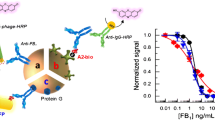Abstract
Enzyme-linked immunosorbent assay (ELISA) is a plate-based immunological assay designed to detect and quantify peptides, proteins, antibodies, and hormones. Fluorescence polarization (FP) is a solution-phase technique that can be used to determine equilibrium dissociation constant of ligand for the protein of interest. Here we describe the protocols for different ELISAs and for Fluorescence Polarization, and how they can be used to determine relative or absolute binding of macrocyclic peptides to the target proteins. In ELISA, the target protein is used as the antigen, and the binding of antigen is quantified using cyclic peptides and enzyme-linked antibodies. In Fluorescence Polarization assays, a cyclic ligand is fluorescent dye-labeled and titrated with serial concentrations of the non-labeled target protein to determine the equilibrium dissociation constant (KD) of ligand for protein. Detailed descriptions of sample preparation and the ELISA and FP experiments are provided in this chapter.
Access this chapter
Tax calculation will be finalised at checkout
Purchases are for personal use only
Similar content being viewed by others
References
Kastritis PL, Bonvin AM (2013) On the binding affinity of macromolecular interactions: daring to ask why proteins interact. J R Soc Interface 10(79):20120835. https://doi.org/10.1098/rsif.2012.0835
Walensky LD, Kung AL, Escher I, Malia TJ, Barbuto S, Wright RD, Wagner G, Verdine GL, Korsmeyer SJ (2004) Activation of apoptosis in vivo by a hydrocarbon-stapled BH3 helix. Science 305(5689):1466–1470. https://doi.org/10.1126/science.1099191
Das S, Nag A, Liang J, Bunck DN, Umeda A, Farrow B, Coppock MB, Sarkes DA, Finch AS, Agnew HD, Pitram S, Lai B, Yu MB, Museth AK, Deyle KM, Lepe B, Rodriguez-Rivera FP, McCarthy A, Alvarez-Villalonga B, Chen A, Heath J, Stratis-Cullum DN, Heath JR (2015) A general synthetic approach for designing epitope targeted macrocyclic peptide ligands. Angew Chem Int Ed Engl 54(45):13219–13224. https://doi.org/10.1002/anie.201505243
Nag A, Das S, Yu MB, Deyle KM, Millward SW, Heath JR (2013) A chemical epitope-targeting strategy for protein capture agents: the serine 474 epitope of the kinase Akt2. Angew Chem Int Ed Engl 52(52):13975–13979. https://doi.org/10.1002/anie.201305882
Moerke NJ (2009) Fluorescence polarization (FP) assays for monitoring peptide-protein or nucleic acid-protein binding. Curr Protoc Chem Biol 1(1):1–15. https://doi.org/10.1002/9780470559277.ch090102
Jameson DM (2014) Introduction to fluorescence. CRC Press, Boca Raton, FL
Banks P, Harvey M (2002) Considerations for using fluorescence polarization in the screening of G protein-coupled receptors. J Biomol Screen 7(2):111–117. https://doi.org/10.1177/108705710200700203
Coffin J, Latev M, Bi X, Nikiforov TT (2000) Detection of phosphopeptides by fluorescence polarization in the presence of cationic polyamino acids: application to kinase assays. Anal Biochem 278(2):206–212. https://doi.org/10.1006/abio.1999.4438
Lynch BA, Loiacono KA, Tiong CL, Adams SE, MacNeil IA (1997) A fluorescence polarization based Src-SH2 binding assay. Anal Biochem 247(1):77–82. https://doi.org/10.1006/abio.1997.2042
Rusinova E, Tretyachenko-Ladokhina V, Vele OE, Senear DF, Alexander Ross JB (2002) Alexa and Oregon green dyes as fluorescence anisotropy probes for measuring protein-protein and protein-nucleic acid interactions. Anal Biochem 308(1):18–25. https://doi.org/10.1016/s0003-2697(02)00325-1
Rozema DB, Poulter CD (1999) Yeast protein farnesyltransferase. pKas of peptide substrates bound as zinc thiolates. Biochemistry 38(40):13138–13146. https://doi.org/10.1021/bi990794y
Lynch BA, Minor C, Loiacono KA, van Schravendijk MR, Ram MK, Sundaramoorthi R, Adams SE, Phillips T, Holt D, Rickles RJ, MacNeil IA (1999) Simultaneous assay of Src SH3 and SH2 domain binding using different wavelength fluorescence polarization probes. Anal Biochem 275(1):62–73. https://doi.org/10.1006/abio.1999.4305
Seethala R (2000) Fluorescence polarization competition immunoassay for tyrosine kinases. Methods 22(1):61–70. https://doi.org/10.1006/meth.2000.1037
Singh KK, Rücker T, Hanne A, Parwaresch R, Krupp G (2000) Fluorescence polarization for monitoring ribozyme reactions in real time. BioTechniques 29(2):344–348., 350–341. https://doi.org/10.2144/00292rr02
Lea WA, Simeonov A (2011) Fluorescence polarization assays in small molecule screening. Expert Opin Drug Discov 6(1):17–32. https://doi.org/10.1517/17460441.2011.537322
Cesa LC, Patury S, Komiyama T, Ahmad A, Zuiderweg ERP, Gestwicki JE (2013) Inhibitors of difficult protein-protein interactions identified by high-throughput screening of multiprotein complexes. ACS Chem Biol 8(9):1988–1997. https://doi.org/10.1021/cb400356m
Rossi AM, Taylor CW (2011) Analysis of protein-ligand interactions by fluorescence polarization. Nat Protoc 6(3):365–387. https://doi.org/10.1038/nprot.2011.305
van Rosmalen M, Janssen BM, Hendrikse NM, van der Linden AJ, Pieters PA, Wanders D, de Greef TF, Merkx M (2017) Affinity maturation of a cyclic peptide handle for therapeutic antibodies using deep mutational scanning. J Biol Chem 292(4):1477–1489. https://doi.org/10.1074/jbc.M116.764225
Xie X, Sun L, Pessetto ZY, Zhao Y, Zang Z, Zhong L, Wu M, Su Q, Gao X, Zan W, Sun Y (2013) Development of a fluorescence polarization based high-throughput assay to identify Casitas B-lineage lymphoma RING domain regulators. PLoS One 8(10):e78042. https://doi.org/10.1371/journal.pone.0078042
Leshchiner ES, Parkhitko A, Bird GH, Luccarelli J, Bellairs JA, Escudero S, Opoku-Nsiah K, Godes M, Perrimon N, Walensky LD (2015) Direct inhibition of oncogenic KRAS by hydrocarbon-stapled SOS1 helices. Proc Natl Acad Sci U S A 112(6):1761–1766. https://doi.org/10.1073/pnas.1413185112
Owicki J (2006) Fluorescence polarization and anisotropy in high throughput screening: perspectives and primer. J Biomol Screen 5(5):297–306
Acknowledgments
This work was supported by New Faculty Start-up grant by Clark University to A. Nag.
Author information
Authors and Affiliations
Corresponding author
Editor information
Editors and Affiliations
Rights and permissions
Copyright information
© 2022 Springer Science+Business Media, LLC, part of Springer Nature
About this protocol
Cite this protocol
Borges, A., Onasenko, I., Nag, A. (2022). Binding Characterization of Cyclic Peptide Ligands to Target Proteins and Chemical Epitopes Using ELISA and Fluorescence Polarization Assays. In: Coppock, M.B., Winton, A.J. (eds) Peptide Macrocycles. Methods in Molecular Biology, vol 2371. Humana, New York, NY. https://doi.org/10.1007/978-1-0716-1689-5_18
Download citation
DOI: https://doi.org/10.1007/978-1-0716-1689-5_18
Published:
Publisher Name: Humana, New York, NY
Print ISBN: 978-1-0716-1688-8
Online ISBN: 978-1-0716-1689-5
eBook Packages: Springer Protocols




